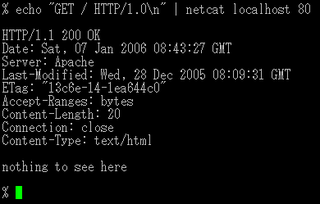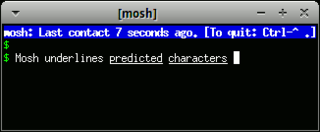The Real Time Streaming Protocol (RTSP) is an application-level network protocol designed for multiplexing and packetizing multimedia transport streams over a suitable transport protocol. RTSP is used in entertainment and communications systems to control streaming media servers. The protocol is used for establishing and controlling media sessions between endpoints. Clients of media servers issue commands such as play, record and pause, to facilitate real-time control of the media streaming from the server to a client or from a client to the server.
In computer networking, the User Datagram Protocol (UDP) is one of the core members of the Internet protocol suite. With UDP, computer applications can send messages, in this case referred to as datagrams, to other hosts on an Internet Protocol (IP) network. Prior communications are not required in order to set up communication channels or data paths.
Helix DNA is a project to produce computer software that can play audio and video media in various formats, aid in producing such media, and serve them over a network. It is intended as a largely free and open-source digital media framework that runs on numerous operating systems and processors and was started by RealNetworks which contributed much of the code. The Helix Community is an open collaborative effort to develop and extend the Helix DNA platform.
SOCKS is an Internet protocol that exchanges network packets between a client and server through a proxy server. SOCKS5 optionally provides authentication so only authorized users may access a server. Practically, a SOCKS server proxies TCP connections to an arbitrary IP address, and provides a means for UDP packets to be forwarded.
OpenVPN is a virtual private network (VPN) system that implements techniques to create secure point-to-point or site-to-site connections in routed or bridged configurations and remote access facilities. It implements both client and server applications.

netcat is a computer networking utility for reading from and writing to network connections using TCP or UDP. The command is designed to be a dependable back-end that can be used directly or easily driven by other programs and scripts. At the same time, it is a feature-rich network debugging and investigation tool, since it can produce almost any kind of connection its user could need and has a number of built-in capabilities.
inetd is a super-server daemon on many Unix systems that provides Internet services. For each configured service, it listens for requests from connecting clients. Requests are served by spawning a process which runs the appropriate executable, but simple services such as echo are served by inetd itself. External executables, which are run on request, can be single- or multi-threaded. First appearing in 4.3BSD, it is generally located at /usr/sbin/inetd.
In computer networking, xinetd is an open-source super-server daemon which runs on many Unix-like systems and manages Internet-based connectivity.
Real-Time Messaging Protocol (RTMP) is a communication protocol for streaming audio, video, and data over the Internet. Originally developed as a proprietary protocol by Macromedia for streaming between Flash Player and a server, Adobe has released an incomplete version of the specification of the protocol for public use.
The Secure Real-Time Media Flow Protocol (RTMFP) is a protocol suite developed by Adobe Systems for encrypted, efficient multimedia delivery through both client-server and peer-to-peer models over the Internet. The protocol was originally proprietary, but was later opened up and is now published as RFC 7016.
HTTP Live Streaming is an HTTP-based adaptive bitrate streaming communications protocol developed by Apple Inc. and released in 2009. Support for the protocol is widespread in media players, web browsers, mobile devices, and streaming media servers. As of 2019, an annual video industry survey has consistently found it to be the most popular streaming format.
Adaptive bitrate streaming is a technique used in streaming multimedia over computer networks. While in the past most video or audio streaming technologies utilized streaming protocols such as RTP with RTSP, today's adaptive streaming technologies are almost exclusively based on HTTP and designed to work efficiently over large distributed HTTP networks such as the Internet. It works by detecting a user's bandwidth and CPU capacity in real time and adjusting the quality of the media stream accordingly. It requires the use of an encoder which can encode a single source media at multiple bit rates. The player client switches between streaming the different encodings depending on available resources. "The result: very little buffering, fast start time and a good experience for both high-end and low-end connections."
Sirannon is a free, open-source, media server and client. The goal is to aid in video research and experimental streaming. Sirannon allows the programmer to create a wide variety of media-handling components such as streaming, reading, writing, packetizing. By organizing these components in a workflow the programmer can create many applications such as a media server, media proxy or video tool. Sirannon was introduced at the ACM multimedia conference in October 2009 under its former name xStreamer.
The Stream Control Transmission Protocol (SCTP) is a computer networking communications protocol in the transport layer of the Internet protocol suite. Originally intended for Signaling System 7 (SS7) message transport in telecommunication, the protocol provides the message-oriented feature of the User Datagram Protocol (UDP), while ensuring reliable, in-sequence transport of messages with congestion control like the Transmission Control Protocol (TCP). Unlike UDP and TCP, the protocol supports multihoming and redundant paths to increase resilience and reliability. SCTP is standardized by the Internet Engineering Task Force (IETF) in RFC 4960. The SCTP reference implementation was released as part of FreeBSD version 7, and has since been widely ported to other platforms.

In computing, Mosh is a tool used to connect from a client computer to a server over the Internet, to run a remote terminal. Mosh is similar to SSH, with additional features meant to improve usability for mobile users. The major features are:
QUIC is a general-purpose transport layer network protocol initially designed by Jim Roskind at Google, implemented, and deployed in 2012, announced publicly in 2013 as experimentation broadened, and described at an IETF meeting. QUIC is used by more than half of all connections from the Chrome web browser to Google's servers. Microsoft Edge and Firefox support it. Safari implements the protocol, however it is not enabled by default.

Packet Sender is an open source utility to allow sending and receiving TCP and UDP packets. It also supports TCP connections using SSL. It is available for Windows, Mac, and Linux. It is licensed GNU General Public License v2 and is free software. Packet Sender's web site says "It's designed to be very easy to use while still providing enough features for power users to do what they need.".
Network Device Interface (NDI) is a royalty-free software specification developed by NewTek to enable video-compatible products to communicate, deliver, and receive high-definition video over a computer network in a high-quality, low-latency manner that is frame accurate and suitable for switching in a live production environment.


